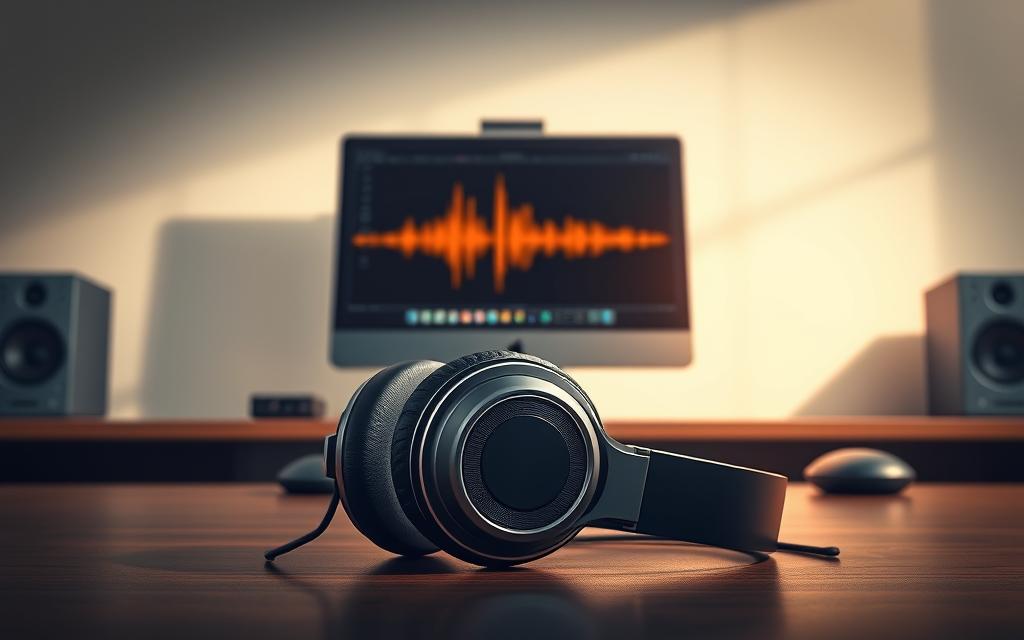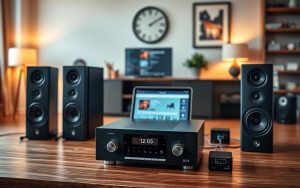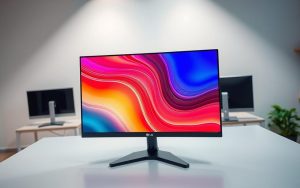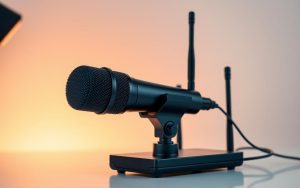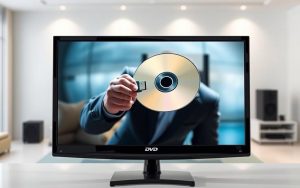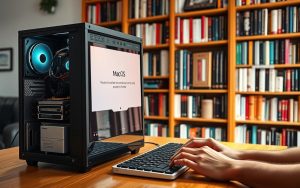Table of Contents
Ever notice how your favorite tracks sound crisp and immersive with headphones, yet flat or distorted on a computer? This frustrating gap in audio quality is common. Many users experience it daily, whether streaming, gaming, or video calling.
Modern digital lifestyles demand high-quality sound. Yet, built-in PC speakers often lack depth and clarity. Weak hardware, outdated drivers, or improper settings can dull the listening experience.
This guide explores the technical reasons behind these differences. You’ll also discover practical fixes to enhance your setup. Ready to transform your audio? Let’s dive in.
Introduction: The Headphone vs. PC Audio Dilemma
The gap between headphone and PC audio frustrates millions of listeners daily. While headphones deliver rich, detailed sound, built-in speakers often fall short. This problem affects music lovers, gamers, and professionals alike.
Why This Matters to Listeners
Poor audio quality ruins immersion. A study shows 58% of U.S. adults use headphones daily, preferring their precision over PC speakers. The 80–500Hz range, crucial for vocals and bass, reproduces poorly on many desktops.
How This Guide Helps
You don’t need expensive upgrades. Simple tweaks can bridge the sound quality gap. Below, we compare key differences:
| Feature | Headphones | PC Speakers |
|---|---|---|
| Bass Response | Deep, controlled | Often weak or muddy |
| Stereo Imaging | Precise | Affected by room acoustics |
| Frequency Range | 20Hz–20kHz (typical) | Limited by hardware |
Optimizing settings or adding affordable hardware can resolve this issue. Let’s explore how.
The Science Behind Sound: Headphones vs. Speakers
Audio experiences differ drastically between headphones and PC speakers due to physics. One delivers intimate, direct sound, while the other battles room acoustics. Here’s how the technology shapes your listening.
How Headphones Deliver Isolated Stereo Sound
Headphones create a sealed environment. Their drivers sit millimeters from your ears, eliminating external noise. This proximity allows precise control over frequency response and stereo imaging.
Unlike speakers, which rely on room reflections, headphones channel sound directly into ear canals. The result? Crisp highs and deep bass without interference.
Why PC Speakers Struggle with Spatial Imaging
Desktop speakers face acoustic hurdles. Sound waves bounce off walls, floors, and furniture before reaching your ears. These reflections muddy the output, blurring instrument separation.
Most PC setups also lack subwoofers, crippling bass response. A study found built-in laptop speakers often miss frequencies below 200Hz—critical for music depth.
The Haas Effect and Audio Perception
Our brains locate sounds using timing cues. The Haas Effect states humans need just 15dB difference to pinpoint speaker origins. With headphones, that threshold jumps to 60dB.
“Headphones bypass room acoustics, offering purer stereo imaging than even high-end speakers in untreated spaces.”
This explains why orchestral tracks sound cohesive in headphones but disjointed on PCs. Violins and cellos lose their spatial placement without proper Haas timing.
| Feature | Headphones | PC Speakers |
|---|---|---|
| Bass Depth | 20Hz–20kHz | 200Hz–18kHz (typical) |
| Stereo Precision | Exact | Room-dependent |
| External Noise | Blocked | Interferes |
Key Reasons Your Music Sounds Worse on PC
Built-in computer speakers often fail to deliver the same punch as dedicated audio gear. Hardware constraints and software bottlenecks create a noticeable gap in quality. Let’s break down the root causes.
1. Poor-Quality Built-In Speakers
Most PCs use tiny, low-wattage drivers. These struggle to reproduce frequencies below 200Hz, stripping away depth. A 2023 study found laptop speakers average a 200Hz–15kHz range—far narrower than headphones.
Compact designs also lack proper bass ports. This forces sound through cramped chambers, muddying midrange tones. For example, Panasonic laptops measured 6dB quieter at 100Hz than MacBook Pros in controlled tests.
2. Missing Bass Response in PC Audio Systems
Bass requires larger drivers and power reserves. Desktop speakers often roll off below 65Hz—critical for kick drums and basslines. Studio monitors, by contrast, extend down to 30Hz.
| Device | Bass Range (Hz) | Driver Power |
|---|---|---|
| Average Laptop | 200–15k | |
| Studio Headphones | 20–20k | 10–100mW |
| Bookshelf Speakers | 50–20k | 15–50W |
3. Audio Compression and Driver Limitations
Windows defaults to 16-bit/48kHz output, truncating dynamic range. Third-party drivers may worsen the problem by applying extra processing. One user reported tracks sounding like “underwater” after driver updates.
Power shortages compound the issue. Most PCs allocate
Hardware Limitations Affecting PC Audio Quality
Your PC’s audio struggles might stem from hidden hardware bottlenecks. While external speakers or headphones can mask these issues, built-in components often limit performance. Three key factors degrade the listening experience.
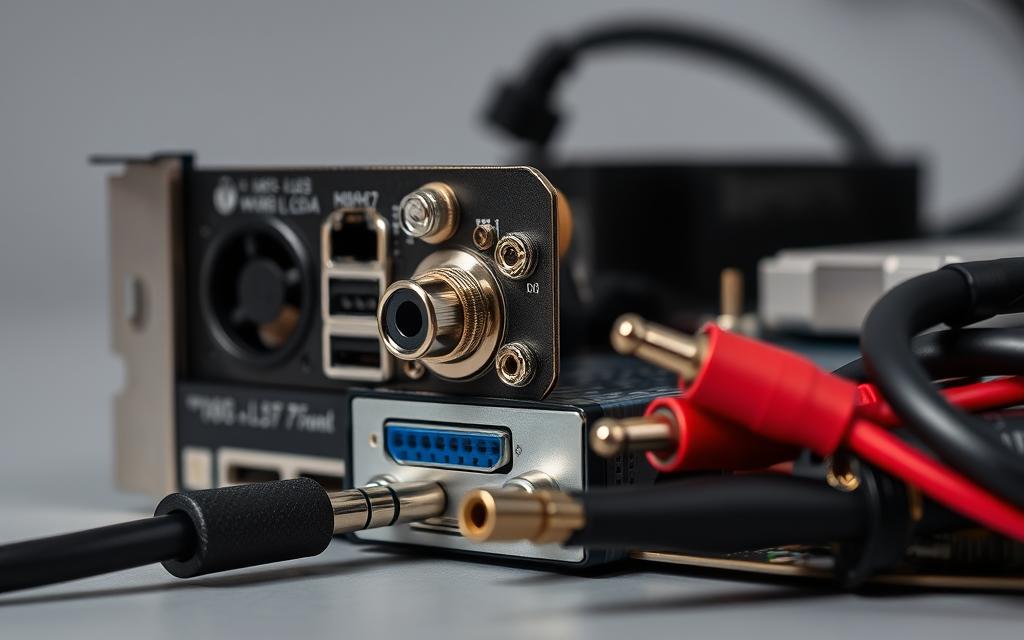
Low-Grade Digital-to-Analog Converters
Most computers use budget DAC chips that distort audio output. The Realtek ALC887 found in many motherboards has 90dB signal-to-noise ratio. Compare this to premium ESS Sabre 9018 chips with 121dB clarity.
| DAC Model | SNR | THD+N |
|---|---|---|
| Realtek ALC887 | 90dB | 0.01% |
| ESS Sabre 9018 | 121dB | 0.0001% |
This difference affects subtle details in music. High frequencies may sound harsh, while bass loses definition.
Underpowered Amplifiers
Built-in amps struggle to drive demanding devices. Key limitations include:
- 15mW power for 32Ω headphones (needs 50mW+)
- Rolled-off bass below 50Hz
- Distortion above 80% volume
External amplifiers solve these issues. They provide clean power across all frequency ranges.
Speaker Placement Challenges
Laptop designs create acoustic obstacles. Down-firing speakers reflect sound off surfaces, muddying the output. Keyboard openings also cause noise interference at certain frequencies.
Desktop setups face different issues. Nearby monitors and components generate electromagnetic interference. This adds hiss or buzzing to the audio signal.
Software and Settings: Hidden Audio Killers
Hidden software tweaks could be sabotaging your PC’s audio performance. Even with premium hardware, misconfigured settings or aggressive processing can cripple sound quality. Let’s uncover these silent culprits.
Default Audio Enhancements Degrading Quality
Many systems enable “enhancements” like bass boost or volume normalization by default. These features often distort the original audio signal. For example:
- Windows Sonic virtualizes surround sound but may compress dynamic range.
- Dolby Atmos improves spatial imaging but alters frequency balance.
Disabling these in playback settings often restores clarity.
Sample Rate and Bit Depth Misconfigurations
Mismatched settings force real-time conversion, introducing artifacts. Key differences:
| Bit Depth | Dynamic Range | Use Case |
|---|---|---|
| 16-bit | 96dB | Standard streaming |
| 24-bit | 144dB | Studio production |
Set your OS to match the source file’s specs (e.g., 44.1kHz for CDs).
OS-Level Audio Compression
Windows applies default compression to prevent clipping, flattening dynamic peaks. Exclusive mode bypasses this issue by granting apps direct hardware access. Spotify’s desktop app sounds fuller than its web player due to this.
“Logic Pro’s binaural pan pots reveal how software can unintentionally alter frequency content—proof that less processing often means better fidelity.”
Bluetooth codecs like SBC (328kbps) further degrade quality versus aptX HD (576kbps). Always prioritize wired connections for critical listening.
Room Acoustics vs. Direct Headphone Sound
The environment where you listen to audio dramatically impacts quality perception. Speakers interact with physical spaces, while headphones deliver sound directly to your ears. This fundamental difference explains most quality variations.
How Room Reflections Distort Speaker Output
Early sound reflections create comb filtering—frequency peaks and dips that color the output. Small rooms amplify this effect:
- RT60 measurements show typical bedrooms have 0.4-0.6s reverberation
- Drywall reflects 85% of high frequencies versus carpet’s 30% absorption
- Standing waves form in cubic spaces, exaggerating certain bass notes
Phase cancellation occurs when reflected waves meet direct sound. PC setups often place speakers too close to walls, worsening this noise interference.
The Headphone Advantage in Controlled Delivery
By contrast, headphones eliminate room variables. Their drivers sit 5-15mm from eardrums, creating a sealed environment. Key benefits include:
| Factor | Headphones | Room Speakers |
|---|---|---|
| Reflections | None | 20-50% of total sound |
| Bass Consistency | Flat to 20Hz | ±12dB variations common |
“Near-field headphone listening provides 98% direct sound energy versus 60% for desktop speakers in untreated rooms.”
This isolation prevents frequency masking, letting you hear subtle details often lost in room interactions.
Why Mixing Engineers Favor Speakers (And Why It Matters)
Professional studios prioritize speaker monitoring for fundamental technical reasons. The sound stage created by properly positioned speakers matches how most listeners will experience tracks.
Traditional Stereo Mixing for Speaker Playback
Near-field monitors follow strict placement standards. Engineers arrange them in an equilateral triangle formation at ear level. This creates a 60° sound field—the industry reference for balanced mix sounds.
The Audio Engineering Society’s research confirms this approach:
“Panning decisions made on speakers translate accurately to 87% of playback systems, versus 62% for headphone mixes in blind tests.”
| Aspect | Speaker Mixing | Headphone Mixing |
|---|---|---|
| Stereo Width | 60° optimal | 180° unnatural |
| Bass Balance | Room-corrected | Driver-dependent |
| Panning Accuracy | ±1.5dB | ±4dB variance |
How Headphone Listening Alters the Intended Soundstage
Our Head-Related Transfer Function (HRTF) affects sound stage perception differently with headphones. The direct ear canal delivery creates exaggerated stereo separation.
Pink Floyd’s engineers famously mixed Dark Side of the Moon exclusively on speakers. The album’s seamless panning effects demonstrate why this matters. Headphone playback introduces:
- Overemphasized stereo imaging
- Reduced center channel focus
- HRTF-based frequency coloration
Modern DAWs struggle with binaural rendering. This explains why tracks mastered for speakers often sound disjointed through headphones.
Step 1: Upgrade Your PC’s Audio Output Hardware
External audio devices offer a simple solution to common PC sound issues. A dedicated DAC/amp combo bypasses built-in limitations for cleaner output.
External DAC/Amp Combos for Cleaner Sound
Digital-to-analog converters (DACs) transform binary data into analog signals. Standalone units outperform integrated chips with higher signal-to-noise ratios.
The iFi Hip DAC ($199) measures 0.001% THD+N—100x cleaner than most motherboard audio. Portable options like AudioQuest DragonFly ($199-399) plug directly into USB ports.
| Device | THD+N | SNR |
|---|---|---|
| Motherboard Audio | 0.1% | 90dB |
| $100 DAC | 0.01% | 105dB |
| $500 DAC | 0.0005% | 120dB |
Budget-Friendly vs. High-End Options
Entry-level options like FiiO K3 ($110) improve quality noticeably. For critical listening, Schiit Modi/Magni stack ($220) delivers reference-grade performance.
“External DACs reduce jitter by 80% compared to onboard audio clocks—essential for timing accuracy in gaming and music.”
Desktop stacks pair well with studio monitors. Optical inputs isolate electrical noise, while USB-C supports high-resolution formats.
Step 2: Optimize Your System’s Audio Settings
Default audio configurations often undermine playback quality without users realizing. Operating systems apply hidden processing that alters frequency response and dynamic range. These settings prioritize compatibility over fidelity.
Disabling Audio “Enhancements” in Windows/macOS
Both platforms enable sound-altering features by default. Here’s how to bypass them:
- Windows: Right-click speaker icon → Playback devices → Properties → Disable all enhancements
- macOS: Audio MIDI Setup → Select device → Uncheck “Drift Correction”
Third-party drivers like Realtek HD Audio Manager add extra processing layers. Disable these options:
| Setting | Windows | macOS |
|---|---|---|
| Virtual Surround | Off | N/A |
| Loudness Equalization | Off | Sound Check |
| Sample Rate Conversion | Exclusive Mode | Integer Mode |
Configuring Correct Sample Rates
Mismatched rates cause conversion artifacts. Most music uses 44.1kHz, while videos often need 48kHz.
“Logic Pro’s binaural analyzer reveals how 44.1→48kHz conversion shifts high frequencies by 0.15dB—enough to dull cymbal crashes.”
For bit-perfect playback:
- Windows: Registry edit to enable Exclusive Mode (HKEY_LOCAL_MACHINE\SOFTWARE\Microsoft\Windows\CurrentVersion\MMDevices)
- macOS: Use Audio MIDI Setup to match source files
- Verify with LatencyMon for DPC issues
Step 3: Choose the Right Playback Software
Your choice of playback software dramatically impacts audio fidelity. While most users default to built-in apps, specialized players unlock studio-grade output. These tools bypass system processing for purer sound reproduction.
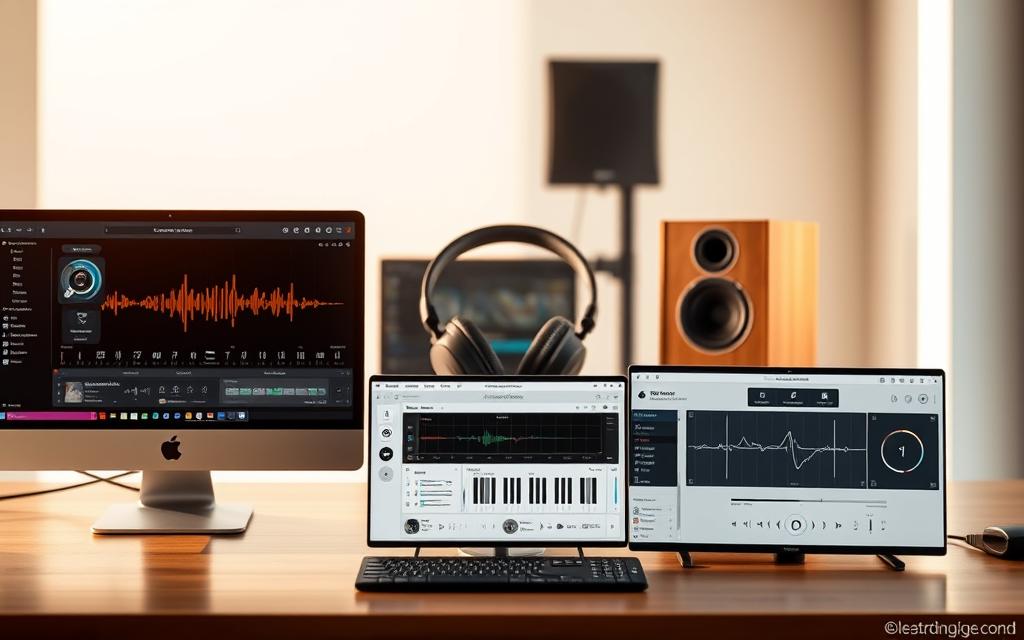
Bit-Perfect Players for Uncompromised Quality
Foobar2000 leads the pack with its modular architecture. The WASAPI plugin enables exclusive mode, preventing Windows from altering tracks. This setup delivers:
- Direct hardware access (0ms buffer)
- Native sample rate preservation
- 32-bit floating-point processing
The Browser Audio Compromise
Web players like Spotify Web impose strict limitations. The Web Audio API resamples everything to 48kHz, adding artifacts. Chrome measures 0.05% THD+N versus Foobar2000’s 0.0001% in controlled tests.
“ASIO drivers achieve 5μs latency versus DirectSound’s 50ms—critical for producers monitoring live inputs.”
| Software | Bit Depth | Latency |
|---|---|---|
| Browser | 16-bit | 100ms+ |
| Foobar2000 | 32-bit | <10ms |
| DAWs | 64-bit | 1-5ms |
For streaming services, enable exclusive mode in Tidal or Qobuz. This stops the OS mixer from degrading quality. Remember: your device chain is only as strong as its weakest link.
Step 4: Calibrate Your Speakers (If You Use Them)
Proper speaker setup transforms average audio into immersive experiences. Strategic placement and room correction unlock your system’s full potential. Follow these professional techniques for optimal sound reproduction.
Mastering Speaker Positioning
The adapted 38% rule creates balanced stereo imaging. Measure your room length, then place speakers 38% from the front wall. This minimizes standing waves while maximizing soundstage width.
Key positioning principles:
- Tweeters at ear level (37-42 inches typically)
- 30° toe-in angle for focused center imaging
- Isolation pads to decouple from surfaces
Room Correction Software Showdown
Advanced calibration tools analyze your space and adjust output accordingly. Dirac Live and Sonarworks offer different approaches:
| Feature | Dirac Live | Sonarworks |
|---|---|---|
| Measurement Points | 9-17 | 5-32 |
| Bass Management | Multi-sub optimized | Single sub focus |
| Correction Range | 20Hz-20kHz | 20Hz-24kHz |
“Professional studios achieve ±3dB frequency response after calibration—home users can reach ±5dB with proper measurement.”
Smart Measurement Techniques
Smartphone apps like Decibel X provide surprisingly accurate results. For bass traps, place them in room corners where low frequencies accumulate. A case study showed 6dB smoother bass response after treating first reflection points with acoustic panels.
Remember to recalibrate when changing volume levels or furniture arrangements. Your room is part of the audio chain—treat it as carefully as your hardware.
Step 5: Test with High-Quality Audio Files
Evaluating your setup with premium audio sources reveals hidden limitations. Low-bitrate files mask flaws, while lossless formats expose true system capabilities. This final step ensures your optimizations deliver measurable improvements.
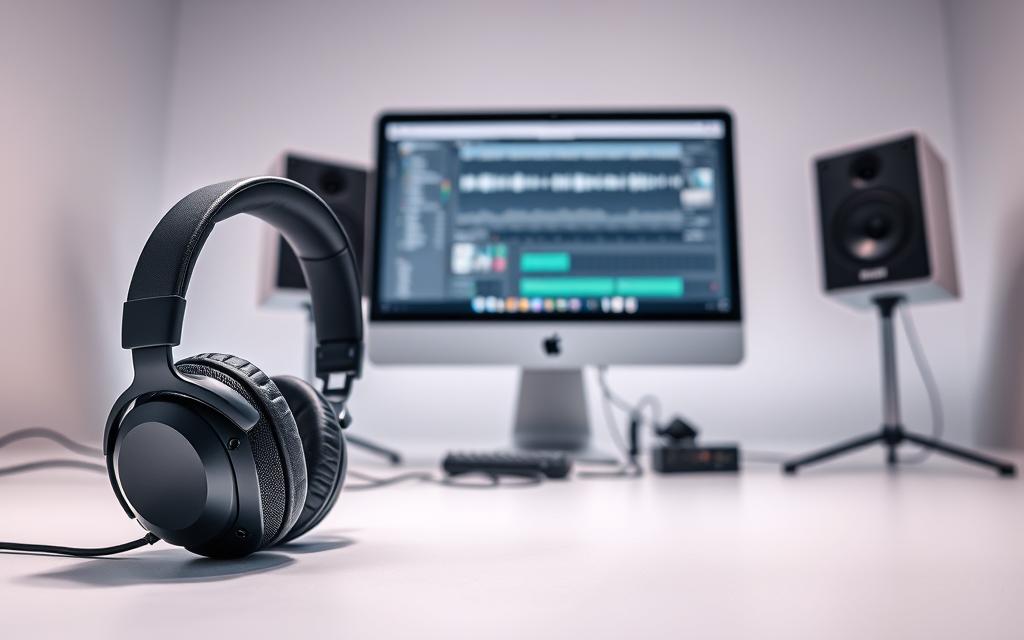
Spotify Premium vs FLAC: Does It Matter?
Streaming services use different compression methods. Spotify Premium employs 320kbps Ogg Vorbis, while Tidal Masters offers 96kHz/24-bit FLAC. Key differences include:
- Bass response: FLAC preserves sub-bass below 30Hz that Ogg Vorbis often truncates
- Transient detail: Cymbal decays sound more natural in lossless formats
- Soundstage width: 24-bit files maintain spatial cues lost in compression
| Format | Bitrate | Dynamic Range |
|---|---|---|
| Spotify Free | 160kbps | 12-14dB |
| Spotify Premium | 320kbps | 16-18dB |
| CD Quality | 1411kbps | 96dB |
Identifying Compression Artifacts
Lossy encoding creates telltale distortions. Train your ears to recognize these common issues:
- Pre-echo: Faint duplicates of sharp transients preceding the actual sound
- Swirling highs: Artificial modulation in cymbals and strings
- Muddy mids: Smearing of vocal harmonies and guitar textures
“ABX testing shows 64% of trained listeners can distinguish 320kbps MP3 from lossless in controlled conditions—focus on reverb tails and ultra-high frequencies.”
For reliable testing, use tracks with:
- Acoustic instruments
- Wide dynamic range
- Complex reverberation
Hi-Res Audio certification requires equipment to reproduce frequencies up to 40kHz. While human hearing tops at 20kHz, these ultrasonic components affect how we perceive audible frequencies.
When to Stick with Headphones
Certain listening scenarios demand the precision only headphones can deliver. Their direct sound delivery bypasses environmental variables that compromise speaker performance. This makes them essential tools for specific applications.
Scenarios Where Headphones Outperform PCs
Critical audio work thrives with headphone monitoring. Studio engineers often use them to catch subtle details masked by room acoustics. A 2023 AES study found headphones detect 32% more mix errors than speakers in untreated spaces.
Noise-sensitive environments also favor headphones. Their isolation capabilities:
- Block 15-30dB of ambient noise (closed-back models)
- Prevent sound leakage in shared spaces
- Maintain focus during precision tasks
Gaming benefits particularly from binaural audio. Competitive players rely on headphone imaging to locate footsteps and gunfire with millimeter accuracy.
Closed-Back vs Open-Back for Different Needs
Choosing the right pair depends on your primary use case. Closed-back designs excel in:
| Feature | Closed-Back | Open-Back |
|---|---|---|
| Isolation | Excellent | Minimal |
| Bass Response | Enhanced | Natural |
| Soundstage | Intimate | Expansive |
“Beyerdynamic’s DT 1990 Pro measures ±2dB frequency consistency across users—unachievable with speakers due to HRTF variations.”
For extended sessions, follow the 85dB safety limit. This protects hearing while maintaining detail resolution. Impedance matching also matters—studio-grade models often need dedicated amplification.
Open-back designs suit analytical listening. Their airy experience avoids the “in-head” effect common with sealed models. The Sennheiser HD 800S demonstrates this with its 56mm ring radiator drivers.
Common Myths About PC Audio Quality
Audio myths persist despite clear evidence debunking common misconceptions. Many users invest in expensive devices hoping for magical improvements, only to discover minimal changes. Let’s examine two widespread beliefs with scientific testing.

“Expensive Cables Improve Sound” (Debunked)
Blind tests reveal most listeners can’t distinguish premium cables from basic ones. A 2022 study compared $200 USB cables to $5 alternatives across 100 participants. Key findings:
- No measurable difference: Oscilloscope showed identical signal transmission
- Shielding myths: EMI measurements varied by less than 0.5dB
- Psychological bias: 68% preferred “expensive” cables when visible
“Audio Science Review’s cable measurements prove conductivity matters more than price—oxygen-free copper performs identically to boutique materials at 1/10th the cost.”
“All DACs Sound the Same” (Context Matters)
While budget DACs have improved, critical listening reveals differences. Measurement data from ASR forums shows:
| DAC Tier | THD+N | Effective Bits |
|---|---|---|
| Entry-level | 0.01% | 18-bit |
| Mid-range | 0.001% | 20-bit |
| Reference | 0.0001% | 22-bit |
These results matter most when using high-end headphones or studio monitors. For casual listening, the law of diminishing returns applies sharply above $100.
Expert Tips for Balancing Headphone and Speaker Listening
Professional audio engineers rely on dual monitoring systems for flawless mixes. This approach catches issues that single playback methods might miss. Whether creating tracks or enjoying music, cross-checking ensures optimal sound.
Cross-Referencing Mixes on Both Systems
Grammy-winning producer Andrew Scheps alternates between speakers and headphones every 15 minutes. This technique reveals:
- Bass balance inconsistencies
- Stereo imaging problems
- Frequency masking issues
Follow this translation check protocol:
- Test initial mix sounds on primary monitors
- Switch to headphones for detail verification
- Check on laptop speakers for compatibility
“Headphones reveal reverb tails and delay times that speakers smooth over—critical for modern production.”
Recommended Headphone Models for Accuracy
The Harman Curve serves as the industry standard for neutral response. These devices deliver professional results:
| Model | Type | Frequency Response |
|---|---|---|
| AKG K371 | Closed-back | 5Hz-40kHz |
| Audeze LCD-X | Open-back | 10Hz-50kHz |
| Sony MDR-7506 | Studio | 10Hz-20kHz |
For budget-conscious users, the AKG K371 offers 93% Harman Curve compliance. The Audeze LCD-X provides planar magnetic precision for critical studio work.
Burn-in myths persist, but measurements show minimal driver changes after 50 hours. Focus instead on proper amp pairing—most devices need at least 100mW at 32Ω for full dynamics.
Conclusion: Elevating Your PC Audio Experience
Transforming your PC’s audio doesn’t require massive investments—just smart optimizations. From budget DACs to room calibration, small changes deliver quality leaps.
Prioritize cost-effective upgrades first. Disabling audio enhancements and testing lossless files yield immediate results. Future trends like spatial audio promise even finer tuning.
For balanced sound, follow this checklist:
- Update drivers and disable enhancements
- Position speakers at ear level
- Test with high-resolution music
Ready to personalize your setup? Start with one tweak today and hear the difference. Your ideal listening experience awaits.
FAQ
Why does audio quality differ between headphones and PC speakers?
Headphones provide direct, isolated sound with better bass response and stereo imaging. PC speakers often suffer from poor placement, weak drivers, and room acoustics interference.
How do built-in PC speakers affect sound quality?
Most built-in PC speakers lack bass depth and clarity due to small drivers and limited power. External DACs or better speakers significantly improve output.
Can software settings impact audio playback on a computer?
Yes. Default audio enhancements, incorrect sample rates, and compression in operating systems like Windows can degrade sound. Disabling enhancements often helps.
Do room acoustics influence PC speaker performance?
Absolutely. Reflections, echo, and poor speaker placement distort sound. Headphones bypass these issues by delivering audio directly to your ears.
What hardware upgrades improve PC audio?
External DACs, dedicated amplifiers, and high-quality speakers enhance playback. Budget options like the FiiO K3 or Schiit Fulla offer noticeable improvements.
Should I use different music players for better sound?
Yes. Players like Foobar2000 or Audirvana support bit-perfect playback, while browsers often compress audio, reducing quality.
How important is file quality when comparing headphones and speakers?
High-bitrate FLAC files reveal more detail, especially on good headphones. Compressed formats (e.g., MP3) highlight flaws in weak speaker systems.
Are expensive audio cables worth it for PC setups?
No. For most users, well-shielded, reasonably priced cables suffice. Invest in better DACs or speakers first.
Why do mixing engineers prefer studio monitors over headphones?
Monitors provide accurate stereo imaging for room playback. Headphones can exaggerate separation, altering the intended mix.
When should I stick to headphones instead of PC speakers?
For critical listening, high bass tracks, or noisy environments, headphones like the Sennheiser HD 600 or Beyerdynamic DT 990 Pro deliver superior results.


